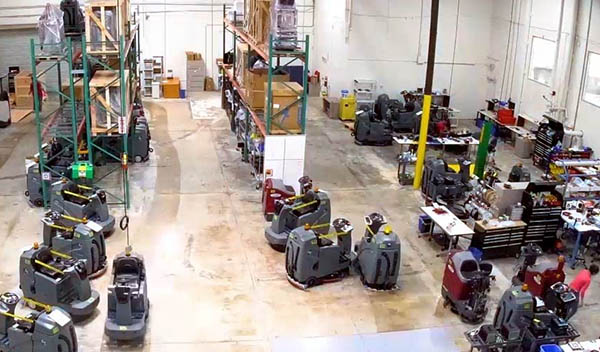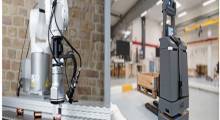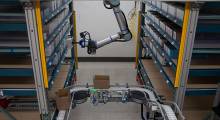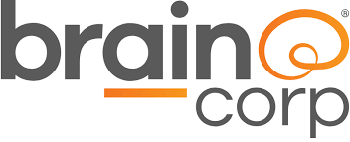Last week, Brain Corp. announced that David Pinn was promoted from chief financial officer to CEO, effective Nov. 1, 2022. He will succeed Dr. Eugene Izhikevich, who founded the company and will become Brain Corp's executive chairman.
San Diego, Calif.-based Brain Corp has developed artificial intelligence to enable manufacturing partners to build, deploy, and scale commercial robots. The company claimed that its BrainOS software and cloud-connected service powers the world's largest fleet of autonomous mobile robots (AMRs) operating in indoor spaces.
Brain Corp said it supports Inventory Scan technology with Tennant Co. at Sam's Club, grew 100% year over year in Europe, and shipped record numbers of the Whiz autonomous vacuum with partner SoftBank Robotics.
Pinn brings experience to Brain Corp
Pinn holds a Bachelor of Science degree in electrical engineering from the University of Texas at Austin and a Masters in Business from the Haas School of Business at the University of California, Berkeley. He was a co-founder of Snaptracs, Qualcomm’s consumer electronics subsidiary. Pinn oversaw the successful sale of the business, which led to a merger with Whistle and a $117 million acquisition by Mars.

Prior to joining Brain Corp, Pinn was head of finance for Antenna79, a technology startup backed by L Catterton, where he helped raise $94.9 million in private equity funding.
Since joining Brain Corp in 2017, Pinn has held a variety of executive positions including chief strategy officer, and most recently, chief financial officer. In these roles, he helped lead Brain Corp’s transformation from a robotics hardware company to a software-as-a-service (SaaS) company. It said Pinn played a key role in securing over $100 million of capital from the SoftBank Vision Fund, Qualcomm Ventures, Hercules Capital, ClearBridge Investments, and Satwik Ventures.
Brain Corp also recently announced Jon Tomason as new chief technology officer.
Robotics 24/7 spoke with Pinn about his outlook for Brain Corp, the target market for BrainOS, and the company's plans for growth.
Brain Corp keeps focus on OEMs
How does your past experience with partnerships, shelf-scanning initiatives, and finances inform your vision as the new CEO of Brain Corp?
Pinn: I've been with Brain for almost five years, and it has been a natural progression in the evolution of the business.
Huge credit goes to Eugene [Izhikevich] for getting the company to where it is today, from a research lab with 40 contract R&D Ph.D.s to a huge global company. This is an opportunity to bring my vision to bear and to take what he has built as a stepping stone.
Our core strategy is intact—we're focusing on the OEM business. We've built technology that helps equipment makers build robots and continue to thrive. That's our differentiator, and we'll keep amplifying that business.
Brain has achieved success with large-scale deployments at the largest retailers. We started with floor care and extended into delivery robots and sensing and data collection to help optimize operations. For us, it's really about activating OEM partners through our technology for cleaning, moving, and sensing.
BrainOS is used in a variety of mobile robot applications. Are there any new areas that you think are promising, such as restaurants?
Pinn: There's an enormous opportunity in retail automation—brick-and-mortar stores are under pressure from online and new trends to omnichannel and home delivery. Retailers can differentiate themselves with automation, and we can help with that transformation by adding value to the retail space.
For the forseeable future, that's where we're focused.
Our technology is applicable to environments like restaurants, but the question for us, given the magnitude of opportunity in retail and with our OEM partners, is whether it makses sense to venture into new areas.
Pinn talks about mentor and partners
With Izhikevich moving to the executive chairman role, how do you see your relationship with him going forward?
Pinn: We’ve been close business partners, and I expect our relationship to remain extremely close. I expect Eugene to continue to be an adviser to the company and to me personally as we pursue our vision of a software platform to enable equipment manufacturers to make commercially successful robots.
In addition, he remains a major shareholder and is going to maintain a great deal of interest.
Is Brain Corp looking for more partners such as SoftBank Robotics? How do assess potential partners?
Pinn: We’re extremely pleased with our suite of partners today. We work with each and every of the top manual floor-cleaning manufacturers—the four major brands are all licensees of BrainOS.
With our robust portfolio of partners, Brain Corp has brand recognition and manufacturing and engineering excellence related to their fields. They have robust sales, service, and support forces for equipment with Brain's software.
We look for quality brands, extensive scale, and domain expertise in a particular field. When you combine that with our software and data collection, you have an unparalleled value proposition.
It might be simpler to be a vertically integrated robot company and design the whole stack, but in going horizontal with software, we've achieved the vision of a platform that's hardware-agnostic. We're able to get instant scale.
ROS, the cloud, and interoperability
How does Brain Corp view open-source software such as the Robot Operating System (ROS)?
Pinn: Open-source has its place. We aren’t religious about open-source versus proprietary software, but we have commercial-grade enterprise solutions, which are different from ROS.
We're laser-focused on every engineering design decision—is this right for fleets of tens of thousands of robots? BrainOS has unique properties making it robust enough for enterprise scale.
What Brain Corp provides to partners is more than a software package. We offer manufacturing tools for how to make a robot, calibrate sensors, and do end-of-line testing. There are diagnostic tools that are not in ROS.
We offer similar tools for deployment and the sales and service teams, not just around sensing the environment and navigating around obstacles. Brain provides a comprehensive technology solution to hardware manufacturers for robot capabilities to be delivered to major retailers worldwide.
How does your company plan to expand the benefits of cloud-connected robotics, such as data collection and ease of management?
Pinn: In addition to “clean, move, and sense,” a fourth area of focus is “flow”—cloud tools, integration with third-party analytics, and creating APIs [application programming interfaces] for data sharing. Data is extremely important for our customers, so it’s a very large focus of our research and development investment today.
We recently announced our move to Google Cloud, which will support more mobile experience, data collection, and more advanced inventory analytics. With Sam's Club, we have more scale than any other robotics company on the planet, and our intention is to build on that scale.
Is interoperability among robots from multiple vendors a concern in terms of fleet management?
Pinn: Commercial environments are different from industrial environments, where one can do a greenfield deployment or have more control. Factories and warehouses can mix and match and create proprietary integrations.
Brain's retail partners value enterprise-grade turnkey solutions. Any given retailer may have a single headquarters, but stores are decentralized and widely spread out widely across geographies. They're less likely to have multiple types of robots.
Through our partner/OEM strategy, we enable retailers to pick and choose from their favorite hardware and analytics vendors, but we provide a single point of training and configuration for store infrastructure and robotics. Commercial users can avoid vendor lock-in while also experiencing enterprise-grade robustness.
Robotics to benefit from 'tailwinds' as Brain seeks talent
With ongoing macroeconomic headwinds, how do you position Brain Corp for profitability? Are you anticipating more funding rounds or competition?
Pinn: Volatility comes with both headwinds and tailwinds. Labor availability has been an increasing challenge for the past 30 years, according to the Bureau of Labor Statistics. The need is becoming more accute, which is a tremendous tailwind for robotics in general.
With all the supply chain challenges, retailers like Walmart and Target need to know in more detail what's happening at the shelf level. That data is important to solving inventory management problems.
With the strong funding we've received historically, we're really confident that we can weather any downturn. We welcome any new competition, which validates our approach.
Are there any initiatives or strategic goals for the coming year that you can share?
Pinn: “Automate the aisle” is a strategic goal for us. We believe we’re in the pole position, since Brain has most robust deployment of any robotics company. My goal for next year is to continue expanding our lead and scope of offerings to help retailers improve efficiency, automate, and compete with e-commerce.
Another goal is for the team to be the go-to destination for talent. We're building out Brain's corporate culture to acquire, develop, and retain top talent, given the unique scale at which we operate. It's a tremendous opportunity for people with expertise in AI, robotics, and automation to know their contribution matters.
About the Author
Follow Robotics 24/7 on Linkedin
Article topics
Email Sign Up

















